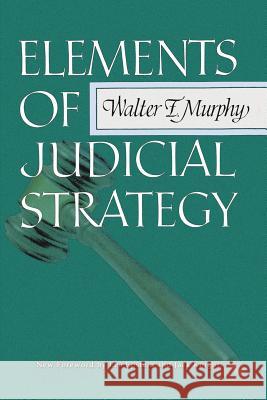Elements of Judicial Strategy » książka
Elements of Judicial Strategy
ISBN-13: 9781610273565 / Angielski / Miękka / 2016 / 258 str.
Elements of Judicial Strategy
ISBN-13: 9781610273565 / Angielski / Miękka / 2016 / 258 str.
(netto: 121,59 VAT: 5%)
Najniższa cena z 30 dni: 127,32
ok. 16-18 dni roboczych
Dostawa w 2026 r.
Darmowa dostawa!
Now in a readily available and modern republication edition, and adding a substantive, detailed 2016 Foreword by Lee Epstein and Jack Knight, this classic of law and political science is presented to a new generation of thoughtful observers of the U.S. Supreme Court and how its justices create judicial decisions. As Epstein and Knight write, this book is "extraordinary. It's the rarest of rare: a breakthrough of the path-marking, even paradigm-shifting, variety...." Its publication offered a "huge conceptual breakthrough. Elements was the first to offer a strategic account" of judging, and its "framework forever changed the study of judicial behavior." It remains influential to current thought, extending even in its "global reach," and is an important part of modern social sciences and law. / / First outlining the sources and instruments - and limitations - of judicial power, the author then shows how policy-oriented justices might take advantage of their power positions to maximize their impact on the formation and execution of public policy. In this book Walter F. Murphy attempts to understand how, under the limitations which the American legal and political systems impose, Supreme Court justices can legitimately act to further their policy objectives. Murphy also considers ethical issues raised by the model of judicial decision-making he describes. Throughout, systematic analysis is supported by prodigious research and fascinating real-world examples over the years and in very different judicial administrations. / / Part of the Legal Legends Series from Quid Pro Books, this edition embeds the page numbers of the original print editions, for purposes of continuity, referencing, course assignment, and convenience to the reader. Its modern presentation and larger, legible type enhance its use for scholars, college students, and other readers. NOTE: only the new edition from QUID PRO BOOKS has the new presentation and introduction, even if this description appears under used copies of older printings."
Now in a readily available and modern republication edition, and adding a substantive, detailed 2016 Foreword by Lee Epstein and Jack Knight, this classic of law and political science is presented to a new generation of thoughtful observers of the U.S. Supreme Court and how its justices create judicial decisions. As Epstein and Knight write, this book is "extraordinary. Its the rarest of rare: a breakthrough of the path-marking, even paradigm-shifting, variety...." Its publication offered a "huge conceptual breakthrough. Elements was the first to offer a strategic account" of judging, and its "framework forever changed the study of judicial behavior." It remains influential to current thought, extending even in its "global reach," and is an important part of modern social sciences and law. /•/ First outlining the sources and instruments - and limitations - of judicial power, the author then shows how policy-oriented justices might take advantage of their power positions to maximize their impact on the formation and execution of public policy. In this book Walter F. Murphy attempts to understand how, under the limitations which the American legal and political systems impose, Supreme Court justices can legitimately act to further their policy objectives. Murphy also considers ethical issues raised by the model of judicial decision-making he describes. Throughout, systematic analysis is supported by prodigious research and fascinating real-world examples over the years and in very different judicial administrations. /•/ Part of the Legal Legends Series from Quid Pro Books, this edition embeds the page numbers of the original print editions, for purposes of continuity, referencing, course assignment, and convenience to the reader. Its modern presentation and larger, legible type enhance its use for scholars, college students, and other readers. NOTE: only the new edition from QUID PRO BOOKS has the new presentation and introduction, even if this description appears under used copies of older printings.











